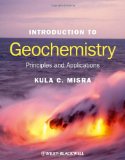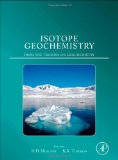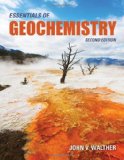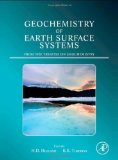Geochemistry
- 20th International Meeting on Organic Geochemistry (IMOG 2001) - Nancy, France, September 10-14, 2001
- 24th International Applied Geochemistry Symposium 2009 University of New Brunswick Fredericton, New Brunswick
- 25th International Applied Geochemistry Symposium (IAGS 2011), Rovaniemi, Finland (22-26 August 2011)
- 9th International Symposium on Experimental Mineralogy, Petrology and Geochemistry - Zurich, March 24 -27, 2002
- VIII International Symposium on Environmental Geochemistry (8 ISEG), Ouro Preto City, Minas Gerais, Brazil
- ACS Division of Geochemistry
- Advanced soil geochemical atlas of England and Wales

- Association of Applied Geochemists
- Association of Petroleum Geochemical Explorationists
- Bayerisches Institut für Experimentelle Geochemie und Geophysik
- Bishop Museum - Hawaiian Volcanic Rocks Geochemical Data
- Carbon and Nitrogen Geochemistry of Wedge Sediments at ODP Site 1040: Evidence for Sediment Sources, Diagenetic History, and Fluid Mobility

- Carbon and Oxygen Isotope Geochemistry along a Subducting Pelagic Section offshore Costa Rica (ODP Legs 170 and 205)

- Center for Environmental Chemistry and Geochemistry
- Contemporary Geochemical characterization methods for reservoir core bitumen and oil – Application to samples from Mid-Norway and the Norwegian Barents Sea – Source Rock Facies and Maturity Assessment & Biodegradation effects as measured on Inclusion gas and Reservoir Oil samples

- Cornell Keck Foundation Isotope Lab - conducts research and graduate student training into the working of the Earth using the tools of isotope and trace element geochemistry
- Database of rocks chemical analyses
- Environmental Geochemistry Notes of Ron Stoessell
- Eötvös University Budapest - Department of Petrology and Geochemistry
- European Association of Organic Geochemists
- Geochemical Analyses of Hydrothermally Altered Sediments from the Convergent Costa Rican Margin

- Geochemical Atlas of Europe
- Geochemical Perspectives online

- Geochemical Society
- Geochemistry
- Geochemistry notes - GSC 300
- Geochemistry of eastern Mediterranean sedimentary cycles : on the origin of Miocene to Pleistocene sapropels, laminites and diatomites
- Geochemistry of Igneous Rocks
- Geokem - Geochemistry of igneous rocks
- GEOROC - Geochemical and isotopic database
- Groundwaters in Geochemical Exploration: Methods, Applications and Future Directions

- High-Resolution Inorganic Geochemistry across the Paleocene/Eocene Boundary, Hole 1221C

- Inorganic Geochemical Characterization of Lithologic Units Recovered during ODP Leg 207 (Demerara Rise)

- Interpretation of Regional Geochemical Survey Data

- Iron Isotope Geochemistry of Mid-Cretaceous Organic-Rich Sediments at Demerara Rise (ODP Leg 207)

- Iso-Analytical - Stable Isotope Analysis
- ISOGEOCHEM - Stable Isotope Geochemistry
- Isotope Geochemistry
- Los Alamos National Laboratory - Geology and Geochemistry Group
- MBL Stable Isotope Laboratory - Providing stable isotope services for research and industry
- Organic Carbon, Total Nitrogen, Carbonate Carbon, and Carbonate Oxygen Isotopic Compositions of Albian to Santonian Black Shales from Sites 1257–1261 on the Demerara Rise

- Organic geochemistry
- Organic geochemistry of Upper Carboniferous bituminous coals and clastic sediments from the Lublin Coal Basin (Poland)

- Organic Geochemistry Speller V. 1.01 for wordprocessor software
- Sulfur-Iron-Carbon Geochemistry in Sediments of the Demerara Rise

- Trace Element Geochemistry
- UGA-Geology - Geochemistry
- Vinograclov Institute of Geochemistry (Irkutsk)
- Volcano and Mantle Geochemistry
- Woods Hole Petroleum Organic Geochemistry Group
- Aalborg University - Environmental Geochemistry Laboratory
- Aberdeen University - Organic & Petroleum Geochemistry group
- Bratislava Faculty of Natural Sciences (Slovakia) - Department of Geochemistry
- Bremen Universität - Fachgebiet Geochemie & Hydrogeologie
- Bristol University - Aqueous and Environmental Geochemistry
- Colorado School of Mines - Geochemistry
- Hiroshima University, Department of Earth and Planetary Systems Science - Isotope Geochemistry Group
- Illinois University - Organic Geochemistry laboratory
- Johannes Gutenberg-Universität Mainz - Max-Planck-Institut für Chemie - Abteilung für Geochemie
- South Carolina University - Organic Geochemistry Lab
- Utrecht University - Geochemistry
- Washington University - Aquatic Organic Geochemistry
- Wien Universität - Institut für Geochemie
Books about geochemistry





